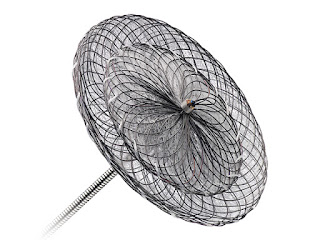A collapsible medical device (60) comprising a metal fabric formed of braided strands, the device (60) having a collapsed configuration for delivery through a channel in a patient's [body], and has a generally dumbbell-shaped expanded configuration with two expanded diameter portions (64) separated by a reduced diameter portion (62) formed between opposed ends of the device, characterized in that clamps (15) are adapted to clamp the strands at the opposed ends of the device.
 |
| The Amplatzer PFO Occluder |
 |
| The Occlutech alleged infringement. |
The question, which was put before courts in the UK, Sweden, the Netherlands and Germany (see also here for a summary of the cases), was whether the claim above could be construed to cover the Occlutech device. On a straightforward literal interpretation it clearly couldn't, because the Occlutech device didn't have a clamp at both ends, but only at one end. Could it, however, be infringed based on a doctrine of equivalents? This is the subject of an upcoming "Round Table" session organised by UNION-IP, to be held in Munich on 24 February (regular readers will recall that I attended and presented on partial priority at the event last year, which I reported on here). Details of this year's session are provided below.
For more information and how to book, please see the UNION-IP website.
UNION-IP Round Table Program, February 24, 2017
Literal infringement and the doctrine of equivalence from a European perspective - How should one draft patents that are infringed?
The landmark decision "Occlusion device", rendered by the BGH, started intense discussion amongst practitioners as to how to draft patents that can be successfully enforced. UNION-IP picks up this discussion, and connects together the jurisprudence which has been developed since the Occlusion device decision regarding the questions of literal infringement and doctrine of equivalence when drafting patents with a European perspective.
What lessons need to be learned? What are the pitfalls to be avoided? In brief, how does one draft a patent that can be infringed? We will hear views from experienced judges, litigators and patent attorneys on these points.
08:15 - 08:45 Registration
08:45 - 09:00 Welcome words
Luigi Franzolin, President UNION-IP, Mr. Rothe GPTO
09:00 - 09:45 Do's and Don'ts under Dutch Case Law Experiences from the judge's bench
Edger F. Brinkman, Senior Judge IP Court of The Hague, NL
09:45 - 10:30 Do's and Don'ts under German Case Law Experiences from the judge's bench
Judge Dr. Hermann Deichfuß, Federal Court of Justice, DE
10:30 - 10:50 Coffee Break
10:50 – 11:35 Pitfalls and lucky punch Practical insight from the perspective of the telecommunication industry
Thomas Burchardi, Senior Patent Attorney, Ericsson GmbH
11:35 – 12:20 Pitfalls and lucky punch - Practical insight from the perspective of the pharmaceutical industry
Marco Riensche, Principal Patent Attorney, Novartis AG and Marco Fachini, Senior Patent Attorney, Sandoz Inc.
12:20 - 13:05 Pitfalls and lucky punch The attorney's view
Sabine Agé, Veron & Associés, Lawyer, FR
13:05 - 13:30 Q&A and closing remarks
Jochen Kilchert, Meissner Bolte, President Patents Commission UNION-IP, DE
13:30 - 15:00 Get Together
Hi David,
ReplyDeleteWhat a coincidence that you were involved in drafting a divisional of this (in)famous patent, as I was involved in the Dutch litigation!